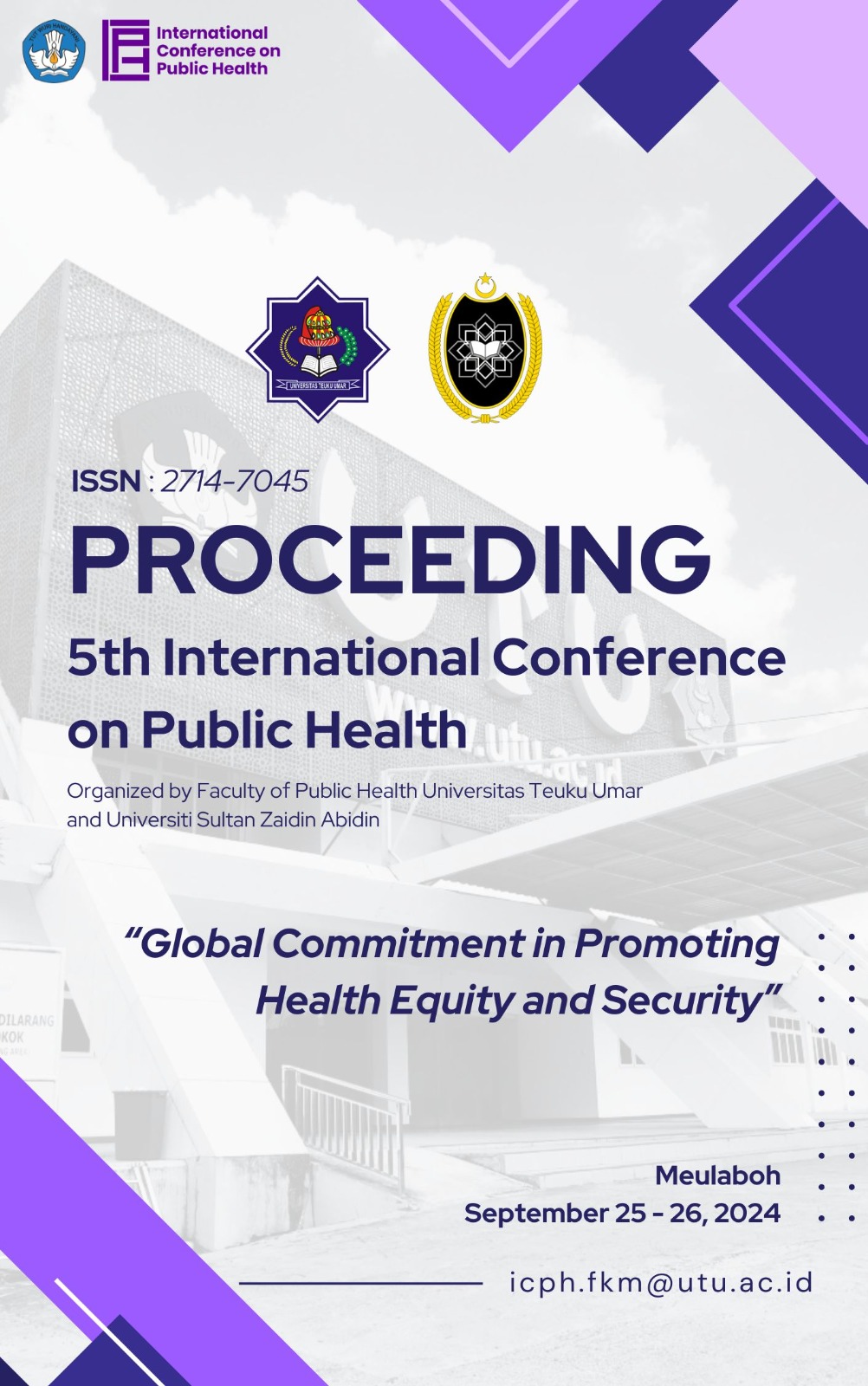Hg Intake by Pregnant Women Living Near Gold Mining
Keywords:
Gold Mining, Mercury (Hg), Pregnant Women, VegetablesAbstract
Living near gold mining areas poses a risk of mercury (Hg) exposure. Exposure to Hg in pregnant women is related to consumption patterns. Pregnant women residing near gold mining sites tend to consume vegetables grown around their homes. Commonly consumed vegetables include papaya leaves, cassava leaves, and katok leaves, all of which have Hg levels exceeding the threshold limit (0.03 g/kg). The Hg intake from these vegetables contributes to the Hg levels in the bodies of pregnant women. The aim of this study is to understand the Hg intake by pregnant women from consuming vegetables in the vicinity of gold mining. A longitudinal observational study was conducted to measure the Hg intake from vegetables by pregnant women living near gold mining areas, using semi-quantitative food frequency questionnaires (FFQ) during interviews to determine the consumption patterns and habits of pregnant women during pregnancy and postpartum. This was done to estimate the daily Hg levels ingested, which were then compared with the EPA (Environmental Protection Agency) guideline stating that the daily allowable intake (ADI) of Hg for pregnant and breastfeeding women is 0.1 μg/kg/day. The results show that the average Hg intake from vegetables collected around the home during pregnancy is 2.57 µg/kg/day, postpartum when the baby is 2-14 weeks old is 5.13 µg/kg/day, and when the baby is 14-26 weeks old is 4.47 µg/kg/day. Therefore, the Hg intake by pregnant women is above the ADI, and if not addressed promptly, it could lead to accumulation in the body and transfer to the baby through the placenta
References
Al-azzawie, H. F., Umran, A., & Hyader, N. H. (2013). Oxidative Stress, Antioxidant Status and DNA Damage in a Mercury Exposure Workers. British Journal of Pharmacology and Toxicology, 4(3), 80–88. https://doi.org/10.19026/bjpt.4.5367
Ali, I., Rondonuwu, S. B., & Dapas, F. N. J. (2019). Analisis Kandungan Merkuri Pada Tanah Dan Umbi Tanaman Ubi Kayu (Manihot Esculenta Crantz) Di Daerah Pertambangan Desa Soyowan, Minahasa Tenggara. Jurnal MIPA, 8(3), 227. https://doi.org/10.35799/jmuo.8.3.2019.26208
Donkor, A. K., Ghoveisi, H., & Bonzongo, J.-C. J. (2024). Use of Metallic Mercury in Artisanal Gold Mining by Amalgamation: A Review of Temporal and Spatial Trends and Environmental Pollution. Minerals, 14(6), 555. https://doi.org/10.3390/min14060555
E.l, A. 2014. (n.d.). Periode Kritis 1000 Hari Pertama Kehidupan dan Dampak Jangka Panjang terhadap Kesehatan dan Fungsinya. Departemen Gizi Kesmas : FKM UI tle.
Ernawati. (2021). Hubungan PAparan Merkuri Dengan Perubahan Marker Oksidatif dan Perkembangan Anak Desa Kalirejo Kecamatan Kokap Kabupaten Kulon Progo Yogyakarta. Disertasi, 140(1), 6.
Gibb, H., & Leary, K. G. O. (2014). Review Mercury Exposure and Health Impacts among Individuals in the Artisanal and Small-Scale Gold Mining Community : A Comprehensive Review. 122(7), 667–672.
Kim, J. H., Lee, S. J., Kim, S. Y., Choi, G., Lee, J. J., Kim, H. J., Kim, S., Park, J., Moon, H. B., Choi, K., Kim, S., & Choi, S. ran. (2016). Association of food consumption during pregnancy with mercury and lead levels in cord blood. Science of the Total Environment, 563–564, 118–124. https://doi.org/10.1016/j.scitotenv.2016.04.082
Palar. (n.d.). Pencemaran dan Toksikologi Logam Berat.
Park, J. D., & Zheng, W. (2012). Human exposure and health effects of inorganic and elemental mercury. Journal of Preventive Medicine and Public Health, 45(6), 344–352. https://doi.org/10.3961/jpmph.2012.45.6.344
Pratiwi, C. A., & Ariesyady, H. D. (2014). Analisis Risiko Pencemaran Merkuri Terhadap Kesehatan Manusia Yang Mengonsumsi Beras Di Sekitar Kegiatan Tambang Emas Tradisional (Studi Kasus: Desa Lebaksitu, Kecamatan Lebakgedong, Kabupaten Lebak, Banten). Jurnal Tehnik Lingkungan, 18(2), 106–114. https://doi.org/10.5614/jtl.2012.18.2.1
S.J.Widowati.W. (n.d.). efek toksik Logam : Pencegahan dan Penanggulangan Pencemaran.
UNEP & WHO. (2008). Children ’ s Exposure to Mercury Compounds.
Valent, F., Horvat, M., Sofianou-Katsoulis, A., Spiric, Z., Mazej, D., Little, D., Prasouli, A., Mariuz, M., Tamburlini, G., Nakou, S., & Barbone, F. (2013). neurodevelopmental effects of low-level prenatal mercury exposure from maternal fish consumption in a mediterranean cohort: Study rationale and design. Journal of Epidemiology, 23(2), 146–152. https://doi.org/10.2188/jea.JE20120030





